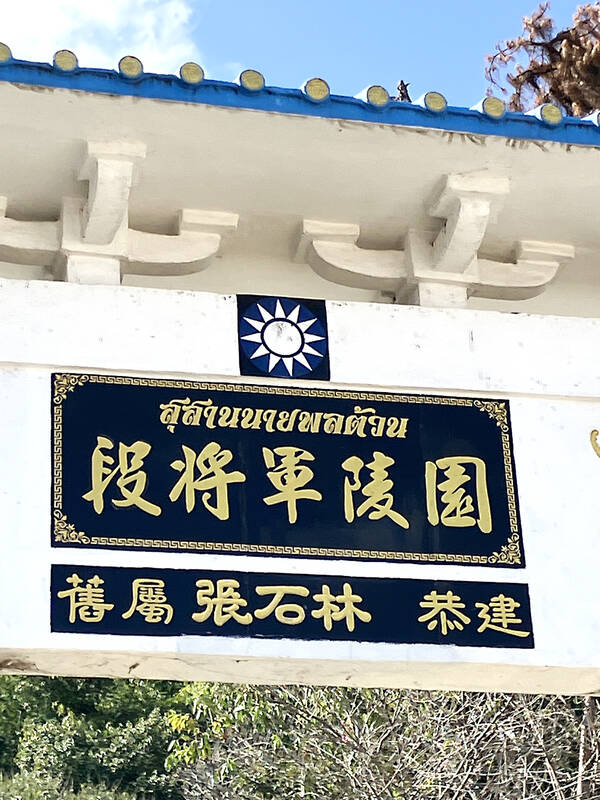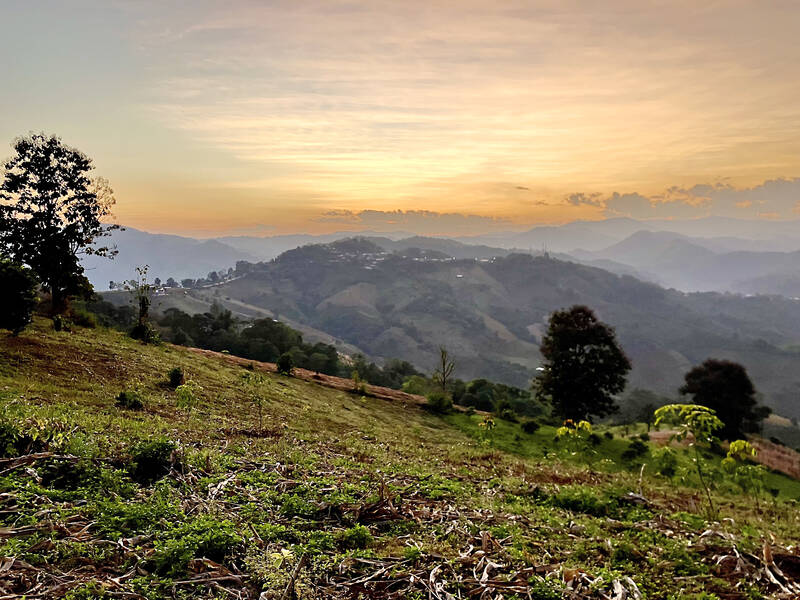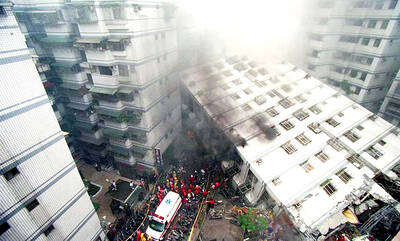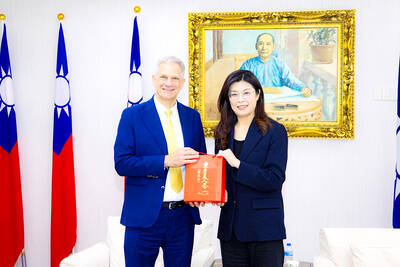Among Thailand’s Chinese Nationalist Party (KMT) villages, a certain rivalry exists between Arunothai, the largest of these villages, and Mae Salong, which is currently the most prosperous. Historically, the rivalry stems from a split in KMT military factions in the early 1960s, which divided command and opium territories after Chiang Kai-shek (蔣介石) cut off open support in 1961 due to international pressure (see part two, “The KMT opium lords of the Golden Triangle,” on May 20).
But today this rivalry manifests as a different kind of split, with Arunothai leading a pro-China faction and Mae Salong staunchly aligned to Taiwan. Last spring at Arunothai’s Jiaolian School, principal Wang Mingming (王明明) had forewarned me of the division between villages, saying, “We are not like the people in Mae Salong. They are rich. Because of the Taiwanese.”
Arunothai has in recent years become split in its loyalties between Taiwan and China (see part one, “A tale of two schools,” on May 15), but in Mae Salong, links to Taiwan remain strong. Taiwan-funded monuments pay homage to the Lost Army, villagers wear T-shirts emblazoned with the Republic of China (ROC) flag and tea plantations grown Taiwan’s most famous tea varieties, including Dong Ding (“frozen peak”) Oolong, Oriental Beauty and Jin Xuan (Golden Daylily or Milk Oolong). Even the numerical classifications of the teas — Oolong No. 12 or No. 17, for example — are the same, and the shops resemble those found on Alishan.

Photo: David Frazier
At the tomb of General Tuan Hsi-wen (段希文) — perched on a Mae Salong hilltop with a view of his ancestral homeland in China’s Yunnan province — a third generation villager wearing a vintage KMT army uniform, Yan Si-Chung (岩思中), greets visitors with sharp military salutes.
“Both my father and my grandfather were soldiers in the KMT army,” the 44-year-old explained. “Taiwan has always been our benefactor, and we can never forget this legacy.”
When the remnants of the KMT’s 5th army under Tuan began to settle at Mae Salong around 1961, prior residents included only about a dozen households of minority hill tribes. When rediscovered by Taiwan’s newspapers 20 years later, the village still had no paved roads or electricity and was in an impoverished state. The nation’s sympathies were aroused for their forgotten comrades.

Photo: David Frazier
In 1987, Soong Mayling’s (宋美齡) Free China Relief Association — now called the Chinese Association for Relief and Ensuing Services (CARES, 中華救助總會) — began sending agricultural advisors and tea tree seedlings as part of a crop substitution plan to rid Thailand of opium, thus building it into one of Thailand’s best known tea producing regions.
At Mae Salong’s western fringe, a Martyrs’ Shrine for the Lost Army sits in the carefully manicured gardens of the North Thailand Heroes Cultural Hall. The building design — brilliant, white stone walls and a roof of orange, ceramic tiles — bears a striking resemblance to Taipei monuments like the Grand Hotel, National Concert Hall and Chiang Kai-shek Memorial. Completed in 2003 with CARES funding, since 2011 its upkeep has been paid for by Taiwan’s Ministry of National Defense. Thai and ROC flags fly side by side inside the shrine’s austere interior.
On a cool, sunny December day in 2023, I met Chao Hsue-yuan (趙學淵), a feisty man in an olive jacket, inside the shrine.

Photo: David Frazier
“I’m 85 years old,” he barked in heavily Yunnan accented Mandarin. “I used to be a soldier in this army.”
Chao said he visited regularly to pay respects to his fallen comrades. His parents were farmers in Yunnan province and the family fled with the KMT retreat in 1949, he said. In 1958, when he was 20 years old, he joined Tuan’s army in Burma.
He led me to an inscription by the author Bo Yang (柏楊), who in the 1960s was among the first to chronicle the Lost Army’s story, writing a series of newspaper columns eventually compiled into a novel titled Foreign Land (異域).

Photo: David Frazier
The inscription reads, “A group that has been forgotten. When they died in battle, they were left to rot like logs and weeds. When they were victorious, they remained unknown on heaven and earth.”
Along the shrine’s back wall, rows of hundreds of small, heavily varnished wooden placards bear the names of departed soldiers.
“Those on the right died of natural causes,” explained Chao, “and those on the left died in combat.”
The placards were roughly equal in number.
CHINESE TOURISTS
That night, in a local guest house with cozy rooms and views of the surrounding mountains, the proprietor Hsiung Chia-hua (熊家華), a kindly man in his 60s, showed photos of his father, a 5th army officer, posing together with Tuan.
He reminisced about his student days in Taipei, where he attended high school on a Taiwan government scholarship, then served two years in the military and was naturalized as an ROC citizen.
“The people here of my generation” — those now in their 50s and 60s — “almost all of us went to school in Taiwan,” he smiled.
He asked me if I’d ever eaten at one of Taipei’s oldest Thai restaurants, the Mandala Yunnan-Thai Restaurant near National Taiwan University.
“It was started by a former Mae Salong villager,” he said.
But Hsiung lamented that a strong sense of identity is dying with the new generation.
“Our children, the fourth generation, they speak Thai in school, learn Mandarin in the evenings and speak Yunnanese at home. The Thai names on their passports are completely different from the Chinese names they are given when they are born. Theirs will be a different world,” he said.
Though Mae Salong derives much of its identity from Taiwan, it is, after decades of living in a time capsule, waking up to a world that’s changing on its doorstep.
Many foreign tourists now come from China, and local business owners welcome them.
“They like to listen to our stories. I think it is kind of nostalgic for them,” Hsiung said. “And it is good that they come and spend money.”
In the Martyrs’ Shrine, a high school teacher from Chaozhou, Guangdong province asked endless questions of a local volunteer guide with fascination for what she considered to be “living history.”
“KMT history is actually Chinese history,” said the teacher matter-of-factly.
HISTORICAL MEMORY
Amid the standoff in the Taiwan Strait, China and Taiwan are also engaged in what many now call a battle for “historical memory,” with each side advancing narratives in support of their political goals — independence for Taiwan, and unification for China.
While Taiwan fights with rhetoric, China fights with censorship, aggressively working to suppress any mention of Taiwan in the global arena. Chinese officials have pressured foreign organizations and businesses to censor and remove references that suggest Taiwan is independent from China in art biennials, academic conferences and even the dropdown menus on airlines Web sites.
China’s objectives, said Chris Horton, Taipei-based author of Ghost Nation: The Story of Taiwan and its Struggle for Survival, are “to erase Taiwaneseness and dehumanize the more than 23 million Taiwanese people.”
Such propaganda could pave the way for a future invasion of the island, he argued.
“If you don’t think of Taiwanese people as existing or being human, that makes it easier to look at the annexation of Taiwan as an abstract matter and to ignore the millions of people that would be killed, injured or traumatized in a war of conquest.”
China’s info wars have also included the rewriting of history, ironically including rehabilitations of the popular images of the KMT and Chiang Kai-shek, former arch-enemies vilified during the Mao Zedong (毛澤東) years as “reactionaries” and “bandits.” In recent films and exhibitions in China, Chiang is now presented as an honorable former leader who defended against the Japanese during World War II and fought for national unity.
But China’s revisionism doesn’t stop there. As they exist today, both the KMT and the ROC are being recast as a period of Chinese history that dovetails into a CCP-controlled future.
Today’s KMT, which still basks in its glory of the 1930s when it was China’s absolute ruler, has welcomed the CCP’s validation as its own support has diminished with Taiwan’s voters. Party-to-party relations resumed in 2005, following the re-election of Taiwan’s first Democratic Progressive Party (DPP) president, Chen Shui-bian (陳水扁). In the 20 years since, China’s top officials have regularly welcomed KMT party leaders for closed-door talks in China.
The former enemies have come together in the shared belief that there is only “one China” and that Taiwan is part of China, although each side has its own interpretation of what that means. Practical areas of cooperation include plans for economic and cultural integration across the Taiwan Strait and combating Taiwan’s ruling DPP, whom Beijing hardliners consider to be “separatists.”
“They are both Han ethno-nationalist parties who view Taiwaneseness as inferior to Chineseness,” said Horton.
“Whether you’re a Chinese ethnonationalist or you just want power, [the KMT has found that] the CCP has a lot to offer as a partner,” he added.
Beijing’s soft embrace of the KMT can be viewed more broadly as part of Xi’s ambition to ideologically “re-territorialize” overseas Chinese communities all around the world, also including Thailand’s Yunnan villages, according to Hong Kong-based scholar Enze Han (韓恩澤).
Xi, even before becoming China’s president in 2012, envisioned overseas Chinese as part of a global polity ready to aid the motherland.
“The tens of millions of overseas Chinese across the world are all members of the Chinese family,” Xi said in a 2014 speech. “In the best of Chinese traditions, generations of overseas Chinese never forget their home country, their origins.”
Beijing has also directed its overseas educational missions to serve as instruments of Communist Party ideology. After the Party’s National Congress in 2022, a major policy meeting held once every five years, China’s Ministry of Education in early 2023 announced that international Chinese-language education should be applied to the “urgent building” of a discourse that presents “a credible, likable and respectable image” of China. International students, the ministry instructed, should be cultivated as “external shapers” of China’s image.
During my visit to Arunothai’s Jiaolian School, Wang Mingming told me that the Chinese Consulate in Chiang Mai had just sent all surviving KMT veterans a red envelope, a traditional ceremonial gift, containing 600 Thai baht, or around US$18 in cash. This was at the end of February last year, about two weeks after the Chinese New Year, a natural occasion for Chinese to distribute such cash gifts and rekindle relationships.
When I asked Wang what her teachers would say if Taiwan and China came up in class, she replied, “The principle of instruction is simple. The two belong to the same family. It’s just two brothers fighting, and then they separate. And then one day they come back and become a family again.”
The DPP rejects the idea that Taiwan and China are estranged brothers. But it has also vacillated in its outreach to Thailand’s Yunnan villages, and this wavering support has created a new set of problems — which will be the subject of the next article in this series.
This is part three in a five-part series on Thailand’s Chinese diaspora and its shifting relationships between Taiwan and China.

Seven hundred job applications. One interview. Marco Mascaro arrived in Taiwan last year with a PhD in engineering physics and years of experience at a European research center. He thought his Gold Card would guarantee him a foothold in Taiwan’s job market. “It’s marketed as if Taiwan really needs you,” the 33-year-old Italian says. “The reality is that companies here don’t really need us.” The Employment Gold Card was designed to fix Taiwan’s labor shortage by offering foreign professionals a combined resident visa and open work permit valid for three years. But for many, like Mascaro, the welcome mat ends at the door. A

If China attacks, will Taiwanese be willing to fight? Analysts of certain types obsess over questions like this, especially military analysts and those with an ax to grind as to whether Taiwan is worth defending, or should be cut loose to appease Beijing. Fellow columnist Michael Turton in “Notes from Central Taiwan: Willing to fight for the homeland” (Nov. 6, page 12) provides a superb analysis of this topic, how it is used and manipulated to political ends and what the underlying data shows. The problem is that most analysis is centered around polling data, which as Turton observes, “many of these

Divadlo feels like your warm neighborhood slice of home — even if you’ve only ever spent a few days in Prague, like myself. A projector is screening retro animations by Czech director Karel Zeman, the shelves are lined with books and vinyl, and the owner will sit with you to share stories over a glass of pear brandy. The food is also fantastic, not just a new cultural experience but filled with nostalgia, recipes from home and laden with soul-warming carbs, perfect as the weather turns chilly. A Prague native, Kaio Picha has been in Taipei for 13 years and

Since Cheng Li-wun (鄭麗文) was elected Chinese Nationalist Party (KMT) chair on Oct. 18, she has become a polarizing figure. Her supporters see her as a firebrand critic of the ruling Democratic Progressive Party (DPP), while others, including some in her own party, have charged that she is Chinese President Xi Jinping’s (習近平) preferred candidate and that her election was possibly supported by the Chinese Communist Party’s (CPP) unit for political warfare and international influence, the “united front.” Indeed, Xi quickly congratulated Cheng upon her election. The 55-year-old former lawmaker and ex-talk show host, who was sworn in on Nov.